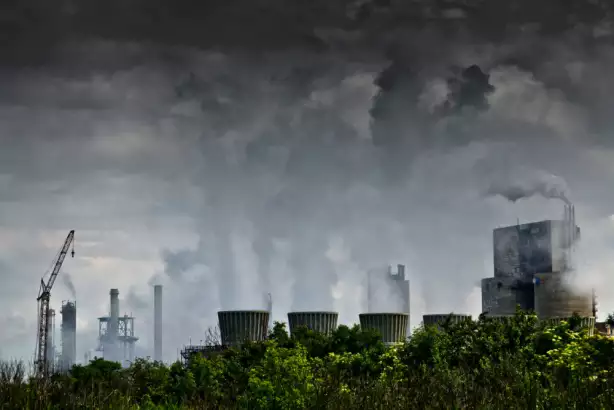How to calculate the size of an RTO for air pollution control?
Giới thiệu
– Importance of air pollution control
– Introduction to Regenerative Thermal Oxidizer (RTO)
– Objective: Understanding the process of calculating the size of an RTO for air pollution control
Factors to Consider in RTO Sizing
– Process Parameters:
– Volume and composition of exhaust gas
– Temperature and pressure
– Pollutant concentration
– Destruction Efficiency Requirement:
– Regulatory standards
– Environmental impact
– Residence Time:
– Time required for the pollutants to be adequately treated
– Determined by the rate of reaction and the RTO design
Calculating the Airflow Rate
– Determine the Volatile Organic Compounds (VOCs) concentration in the exhaust gas
– Calculate the mass flow rate of VOCs by multiplying the concentration with the exhaust gas flow rate
Heat Recovery Considerations
– Determine the heat recovery efficiency required
– Calculate the heat recovery rate based on the desired efficiency and the heat content of the exhaust gas
– Adjust the airflow rate considering the heat recovery requirements
Equipment Sizing and Design
– Consider the RTO’s thermal energy requirements
– Calculate the required combustion chamber size and airflow rate
– Design the heat exchangers based on the heat recovery rate and temperature difference
Optimizing RTO Size
– Evaluate the impact of different RTO sizes on capital and operational costs
– Consider the availability of physical space for the RTO installation
– Assess the long-term performance and flexibility of the chosen RTO size
Phần kết luận
– Calculating the size of an RTO for air pollution control involves considering various factors such as process parameters, destruction efficiency requirements, residence time, airflow rate, heat recovery considerations, and equipment sizing. Optimizing the RTO size is crucial to ensure effective air pollution control while minimizing costs. By following the steps outlined in this article, you can determine the appropriate size for an RTO tailored to your specific air pollution control needs.


How to Calculate the Size of an RTO for Air Pollution Control?
Our company is a high-tech enterprise specializing in comprehensive treatment of volatile organic compounds (VOCs) waste gas and carbon reduction and energy-saving technologies. We have four core technologies: thermal energy, combustion, sealing, and automatic control. In addition, we have the ability to simulate temperature fields and air flow fields, model calculations, and test the characteristics of ceramic heat storage materials, molecular sieve adsorption materials, and high-temperature incineration oxidation of VOCs organic compounds.
Our team has established an RTO technology R&D center and waste gas carbon reduction and engineering technology center in Xi’an, and a 30,000 square meter production base in Yangling. As a leading manufacturer of RTO equipment and molecular sieve wheel equipment in the world, our core technology team comes from the Liquid Rocket Engine Research Institute of the Aerospace Academy of Sciences. We have more than 360 employees, including more than 60 R&D technical backbone personnel, 3 senior engineers, 6 senior engineers, and 47 thermodynamics doctors.
Our core products are RTO and molecular sieve adsorption and concentration wheels. Combining our environmental protection and thermal energy system engineering expertise, we can provide customers with comprehensive solutions for industrial waste gas treatment and carbon reduction and utilization in various operating conditions.
Chứng nhận, Bằng sáng chế và Danh hiệu

- Knowledge Property Management System Certification
- Chứng nhận hệ thống quản lý chất lượng
- Chứng nhận hệ thống quản lý môi trường
- Chứng chỉ Doanh nghiệp xây dựng
- Doanh nghiệp công nghệ cao
- Rotary Valve Type Heat Storage Oxidation Furnace Patent
- Rotary Wing Heat Storage Incinerator Equipment Patent
- Disc-shaped Molecular Sieve Rotary Wheel Patent
Cách chọn thiết bị RTO phù hợp

- Xác định đặc tính của khí thải
- Hiểu các quy định và tiêu chuẩn khí thải của địa phương
- Đánh giá hiệu quả năng lượng
- Xem xét hoạt động và bảo trì
- Phân tích ngân sách và chi phí
- Choose the right type of RTO
- Xem xét các yếu tố môi trường và an toàn
- Perform performance testing and verification
When choosing RTO equipment, it is important to carefully evaluate each of the above factors to ensure you select the right solution for your specific needs. Our team can assist with this process, providing expert guidance for every step of the way.
RTO Air Pollution Control Service Process
We offer a comprehensive service process for RTO air pollution control:
- Initial consultation, on-site inspection, and needs analysis
- Solution design, simulation modeling, and solution review
- Custom production, quality control, and factory testing
- On-site installation, commissioning, and training services
- Regular maintenance, technical support, and spare parts supply
We are your one-stop-shop for RTO air pollution control solutions. Our expert team can provide customized solutions tailored to your specific needs.
Tác giả: Miya
